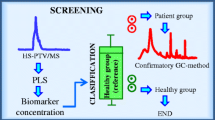Abstract
Objectives: The goal of the present study was to develop an automated method to assess by biological monitoring, the volatile-anaesthetic exposure (nitrous oxide, sevoflurane, isoflurane and halothane) in operating theatre personnel. Methods: Post-shift urine samples were analysed by gas chromatography-mass spectrometry coupled with static headspace sampling (GC-MS/HSS); intra-assay %-RSD (n=10) was less than 5% for nitrous oxide and less than 7% for each halogenated vapour. The biomonitoring method was validated with air monitoring data, obtained by personal samplers and a similar GC-MS method. The sensitivity achieved by single ion monitoring (SIM) was sufficient to reveal low biological and environmental exposure averages down to 1 µg/lurine and 0.5 ppm for nitrous oxide and 0.1 µg/lurine and 50 ppb for halogenated compounds, respectively. Results: In 1998 we collected and analysed 714 post-shift urine samples for the biological monitoring of volatile anaesthetics in the urine of the operating-theatre personnel of Sant'Orsola-Malpighi Hospital (Bologna, Italy). Our data showed that nitrous oxide (N2O), the anaesthetic most largely used in general anaesthesia, is still the decisive factor in operating-theatre pollution. Moreover, on the basis of our results, working in close contact with anaesthetics seems to be the main determinant of risk: surgical nurses and anaesthesiologists are the most-exposed professional categories (mean post-shift urinary N2O approximately 65 µg/lurine), while general theatre staff, surgeons, and auxiliary personnel have significantly lower exposure. Conclusions: The biological monitoring of post-shift unmodified urinary volatile anaesthetics was confirmed to be a useful tool for evaluating individual exposure to these chemicals. The urinary concentrations of N2O and of halogenated vapours might reflect, to a certain extent, the external exposure to these compounds, and respiratory air-monitoring data support the validity of biological monitoring. Furthermore, the good relationship between air and urinary concentration of anaesthetics in people working in closer contact with these chemicals may be a good indirect means of revealing the bad air conditions of operating rooms, and may contribute to the highlighting and correction of service defects in anaesthesiology equipment and of human errors.
Similar content being viewed by others
Author information
Authors and Affiliations
Corresponding author
Additional information
Electronic Publication
Rights and permissions
About this article
Cite this article
Accorsi, A., Barbieri, A., Raffi, G. et al. Biomonitoring of exposure to nitrous oxide, sevoflurane, isoflurane and halothane by automated GC/MS headspace urinalysis. IAOEH 74, 541–548 (2001). https://doi.org/10.1007/s004200100263
Received:
Accepted:
Published:
Issue Date:
DOI: https://doi.org/10.1007/s004200100263




